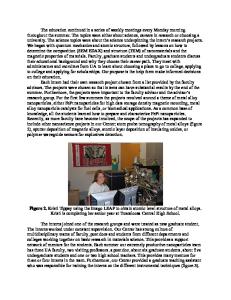The Nanoscience Undergraduate Education (NUE) Program at James Madison University
- PDF / 73,420 Bytes
- 6 Pages / 612 x 792 pts (letter) Page_size
- 27 Downloads / 328 Views
0931-KK01-05
The Nanoscience Undergraduate Education (NUE) Program at James Madison University Brian H Augustine, Barbara A. Reisner, and Kevin L. Caran Department of Chemistry, James Madison University, MSC 4501, Harrisonburg, Virginia, 22812
ABSTRACT We report on the status of the National Science Foundation’s Nanotechnology Undergraduate Education (NSF-NUE) program at James Madison University and the evolutionary changes that are being implemented across the undergraduate chemistry curriculum at JMU. Modifications to classroom lectures, laboratory experiences and demonstrations are being developed from freshman through senior-level courses to provide a theme of nanoscience throughout the undergraduate curriculum. Preliminary assessment data suggests that undergraduate chemistry majors have difficulty understanding molecular-scale dimensions and the forces acting on the nanometer scale, so curricular improvements are particularly aimed at addressing these common misconceptions. An overview of the program is described as well as the status of the activities of the project to date. INTRODUCTION The development of nanoscience and nanotechnology has received considerable interest within the scientific[1, 2] and popular media[3] during the last decade. Proponents hail the manipulation of materials at the nanometer-scale as one of the most significant technological achievements yet devised, while others are much more cautious about the potential of selfreplicating nanomachines causing an environmental or health crisis[4]. While either of these extreme scenarios seems improbable, as scientists and engineers begin to unlock the secrets of manipulating matter at the molecular-scale, it becomes increasingly important to educate and prepare a future workforce and citizenry with an understanding of the basic science and technology underpinning the nanotechnology revolution. To achieve these goals, we must overcome two obstacles: (1) nanoscience coverage is sporadic in the undergraduate curriculum and (2) students have misconceptions about the particulate nature of matter and scaling that make it difficult to appreciate the molecular nature of nanoscience. Undergraduate programs in traditional science disciplines such as chemistry, physics and biology do an admirable job of developing disciplinary foundations. Unfortunately, many departments have not made a concerted effort to develop programs that enable undergraduate students to see the interdisciplinary connections between scientific fields. This effect is likely to be more pronounced at primarily undergraduate institutions (PUIs) from which nearly 60% of our nations’ science students receive bachelor’s degrees. These students then comprise over 20% of the students who eventually receive PhD’s in science, technology, engineering and mathematics (STEM) disciplines[5]. Many students entering graduate programs in STEM disciplines have had limited exposure to course work or research that cuts across the traditional disciplinary boundaries of chemistry and physics. Thus, emerg
Data Loading...











